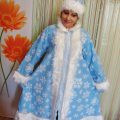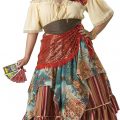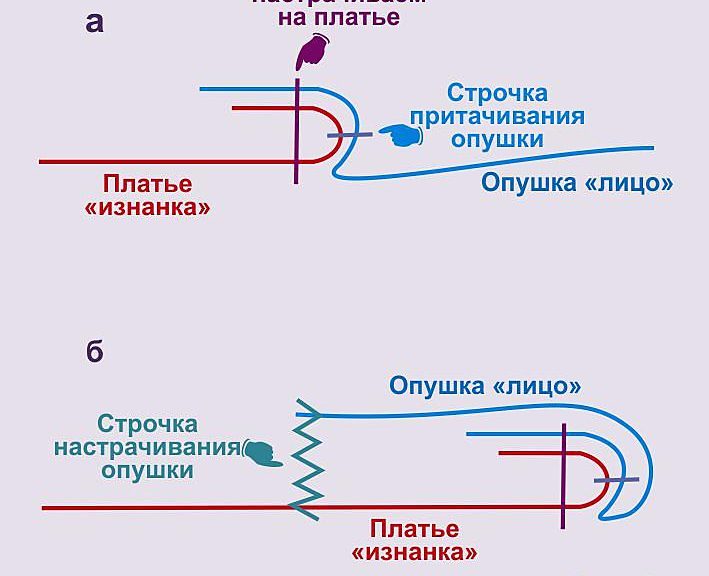
Traditional Snow Maiden costume for New Year from different countries - master class
The procedure for preparing the New Year's holidayis the mass of actions that need to be done before the arrival of the New Year. If you are going to go to a party, or prepare for a trip to the Christmas Ball, you need to prepare a version of your own suit. But, what materials and what patterns can be used to make such a costume yourself? Undoubtedly, you can rent, or buy a brand new suit. But, why not use your own knowledge? We will study the variants of the costumes of the Snow Maiden - the most popular character in the New Year period.
Traditional Snow Maiden costume for New Year from different countries - master class
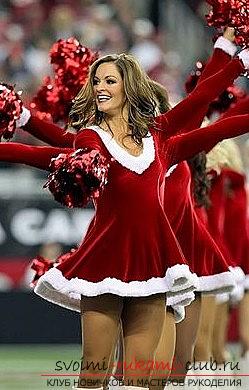 The American snegurochka also exists and shehave your costume. This outfit can be even slightly exotic, but undoubtedly, will suit for "warm" parties, to please yourself and guests with a beautiful appearance. First of all, let us consider the version of the dress of the American Snow Maiden, which consists of a beautiful, but not a long dress. Variations of costumes are very many and they are all related to certain traditions. The United States of America is a young country, according to the traditions of the country, are filled with innovations and all kinds of borrowings from other countries. The fashionable costume of the American Snow Maiden is a vivid confirmation of this fact. Appearance of the costume can not be called modest, nevertheless, it looks very interesting and, accordingly, causes indescribable delight from the observers. Correct pattern and step-by-step approach to work will facilitate the process of understanding each design element inside the suit, allowing you to easily get acquainted with every opportunity to improve or complement the costume. We will need to take a red patch, as well as fur-based without glued elements. Fur can also be called "Stratch" type, as it perfectly combines with different types of knitted fabrics and furs, it is also easy to process. Consumable amount of material should be 1.5 meters with a dress width of 1.4 meters. The expense of a fur basis will demand from you of 30 centimeters of this material. American Snow Maiden Dress
The American snegurochka also exists and shehave your costume. This outfit can be even slightly exotic, but undoubtedly, will suit for "warm" parties, to please yourself and guests with a beautiful appearance. First of all, let us consider the version of the dress of the American Snow Maiden, which consists of a beautiful, but not a long dress. Variations of costumes are very many and they are all related to certain traditions. The United States of America is a young country, according to the traditions of the country, are filled with innovations and all kinds of borrowings from other countries. The fashionable costume of the American Snow Maiden is a vivid confirmation of this fact. Appearance of the costume can not be called modest, nevertheless, it looks very interesting and, accordingly, causes indescribable delight from the observers. Correct pattern and step-by-step approach to work will facilitate the process of understanding each design element inside the suit, allowing you to easily get acquainted with every opportunity to improve or complement the costume. We will need to take a red patch, as well as fur-based without glued elements. Fur can also be called "Stratch" type, as it perfectly combines with different types of knitted fabrics and furs, it is also easy to process. Consumable amount of material should be 1.5 meters with a dress width of 1.4 meters. The expense of a fur basis will demand from you of 30 centimeters of this material. American Snow Maiden Dress 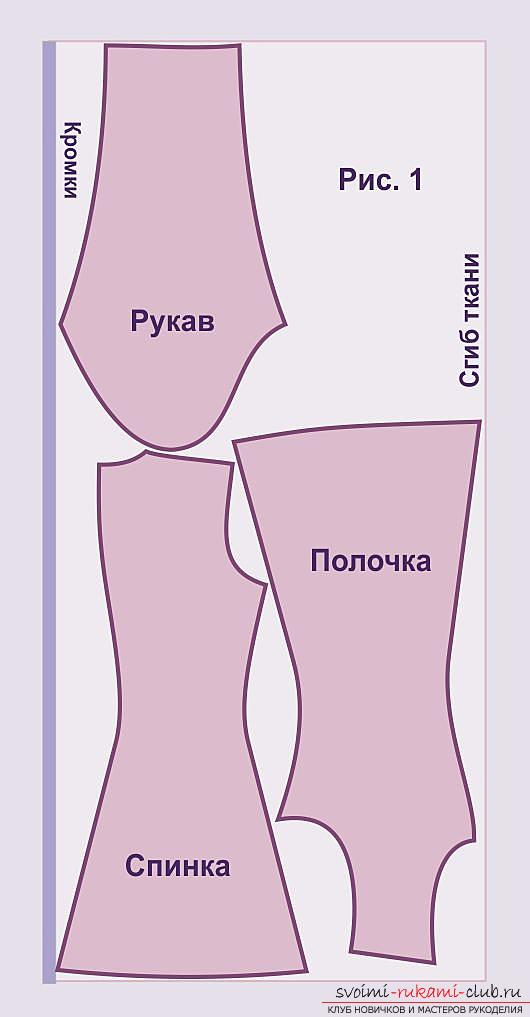 The work should be done using a specialthe scheme presented in the lesson. To begin with, the fabric is folded twice, then - the edges are shifted and placed on the shelf-back by means of a jack. The sleeve of the article is made along the longitudinal part of the edge. In case when a knitted type joint is used at the time of sewing, it is necessary to cut out details without using seam allowances, but it should be taken into account that it is better to perform the work behind the line of patterns (strokes). The actual version of the allowance is 5 millimeters. If you use overlock-string or zigzag, it is also desirable to add a small allowance from 7 millimeters to 1 centimeter on the side, middle and shoulder seams. Also, beginners of this type of needlework should know: the cut of the neck, armhole, sprout or pellet the arm of the sleeve does not form an allowance for the seam.
The work should be done using a specialthe scheme presented in the lesson. To begin with, the fabric is folded twice, then - the edges are shifted and placed on the shelf-back by means of a jack. The sleeve of the article is made along the longitudinal part of the edge. In case when a knitted type joint is used at the time of sewing, it is necessary to cut out details without using seam allowances, but it should be taken into account that it is better to perform the work behind the line of patterns (strokes). The actual version of the allowance is 5 millimeters. If you use overlock-string or zigzag, it is also desirable to add a small allowance from 7 millimeters to 1 centimeter on the side, middle and shoulder seams. Also, beginners of this type of needlework should know: the cut of the neck, armhole, sprout or pellet the arm of the sleeve does not form an allowance for the seam.  At the bottom you can make a small amountmaterial in 1 centimeter for processing, but this fact remains at will. Without a base in the form of a knitted suture, it will be extremely difficult to prepare a Snow Maiden. It is also necessary to cut out the edges, which are also formed using the same patterns as the main cut of the dress. It is very important to comply with the direction for the fur base, as shown in the figure. Next, we begin to work with pricking the lightning, if you envisage it in your work. In the event that there is no lightning at your work, it is necessary to stitch and then, to press the seams of the middle and shoulders. After, it is necessary to stitch the sleeve. You can do this without the preliminary procedure of stuttering. This is because the pattern will take into account the dressing dress you need. Only after the elements of sleeve hooking, as well as the production processes of their chamfering on the armholes, are made, they are pressed and sealed using side seams. To form the edge, we need to connect its particles and then lay it in accordance with this scheme: we put the edge for the sleeves on the sleeve, for the lower part - on the bottom, the neck edge is added to the neck. In this case, the front part of the fur should be in the element in the underside of the dress, and the same seams should be combined and pierced with the help of tail pins.
At the bottom you can make a small amountmaterial in 1 centimeter for processing, but this fact remains at will. Without a base in the form of a knitted suture, it will be extremely difficult to prepare a Snow Maiden. It is also necessary to cut out the edges, which are also formed using the same patterns as the main cut of the dress. It is very important to comply with the direction for the fur base, as shown in the figure. Next, we begin to work with pricking the lightning, if you envisage it in your work. In the event that there is no lightning at your work, it is necessary to stitch and then, to press the seams of the middle and shoulders. After, it is necessary to stitch the sleeve. You can do this without the preliminary procedure of stuttering. This is because the pattern will take into account the dressing dress you need. Only after the elements of sleeve hooking, as well as the production processes of their chamfering on the armholes, are made, they are pressed and sealed using side seams. To form the edge, we need to connect its particles and then lay it in accordance with this scheme: we put the edge for the sleeves on the sleeve, for the lower part - on the bottom, the neck edge is added to the neck. In this case, the front part of the fur should be in the element in the underside of the dress, and the same seams should be combined and pierced with the help of tail pins.  Then, in order to finish the edge, it must be prunedusing the most common, not wide zigzag element. Pritachannya edge bends, and the allowance for seams is spent through the dress. The American dress of the Snow Maiden bends along the edge of the face and is drawn using large, oblique stitches, without tightening. In the last line you need to build, producing a nastrachivanie for the edge of the edge. It is best to use a triple zigzag - it is ideal for work. Fur while ironing is impossible! We also add decor in the form of a pelerine, and also form a cap on one of the patterns in the net. The second variant of cutting for a fur coat The consumption of fabrics for the top part of a product at Du on 100 will make up to 4 and a half meters. Therefore, before preparing the fabric, you should also prepare patterns and determine in advance the parameters of the length of the product. The non-flying lining and its consumption will have the same value as the consumption for the upper part of the tissues. Fly-off linings allow you to save on material. For work you will need:
Then, in order to finish the edge, it must be prunedusing the most common, not wide zigzag element. Pritachannya edge bends, and the allowance for seams is spent through the dress. The American dress of the Snow Maiden bends along the edge of the face and is drawn using large, oblique stitches, without tightening. In the last line you need to build, producing a nastrachivanie for the edge of the edge. It is best to use a triple zigzag - it is ideal for work. Fur while ironing is impossible! We also add decor in the form of a pelerine, and also form a cap on one of the patterns in the net. The second variant of cutting for a fur coat The consumption of fabrics for the top part of a product at Du on 100 will make up to 4 and a half meters. Therefore, before preparing the fabric, you should also prepare patterns and determine in advance the parameters of the length of the product. The non-flying lining and its consumption will have the same value as the consumption for the upper part of the tissues. Fly-off linings allow you to save on material. For work you will need:
- A bit of velvet
- Fur (short version)
- Brocade
- Jacquard
- Artificial fur (collar, sleeves)
The beauty of the product can be determined immediately,the main thing is to choose a good fur. Then, you can choose one of the nesting options that will require different material flow parameters. Consider this before buying fabrics. Most often, fur coats are sewed without insulation, or they insulate only one of the zones (as such fur coats are worn indoors). Remember the rule, which touches the batting on two layers: it is necessary to insulate only the version of the lining, and also that the first layer will reach the bottom of the product, the stitch must be made. The second layer will go up to the thigh level, and then, cover only the outer parts of the sleeves, that is, the hand is warmed only with the help of one layer. For work, use a thin batting. In the case of warming things to the bottom, the skirt can be clumsy and for the carnival costume will not work. The lining can also be insulated, but it is desirable to form a fly-off layer and hold it down. Warming should be carried out to the level of the thigh, but it is possible for the whole product. It all depends on where you are going to put on a suit. It is worthwhile to consider different patterns, for example, the one that we offer. It is worth recalling that the sub-tailoring is performed in a whole (korenny) view in order to save the fabric, as well as your time. It is also better to repeat the under-side part, so that the product is protected from stretch marks. Also, it is worth using the share direction for the collar at the bottom, which is conditionally called "slices on the slanting". The dubbing, which is cut according to the pattern, and also without the allowance on the seam is desirable. You do not need to duplicate the rest of the top part. The allowance for the seam is left in the parameter of one centimeter. It is necessary to do the exclusion only for the cuts of the pellet and the sprout, even for the neck and armhole. They can be cut out behind a line of a stroke on a curve. On the bottom, we indent 3-3.5 centimeters. If you are provided with batting, then it should be cut out on the cut piece, without the allowance on the lower part, and also without a full cut for the bottom. For the rest of the allowances, we do the same. They can be cut off after picking up the upper part, when the seams have already been ironed. Before you cut the lining, in case it is flying off, the lapping must be cut using the thigh level, bending the extensions. The side part should also be bent away from the line for half-pieces, that is, the part for the middle of the shelf will lose about 40 millimeters in width. Such simple and not difficult to perform tips are designed to facilitate the work on the process of creating a future suit. Everyone can take the material that he thinks fit and by patterns from our masters to cut for his own costume of the Newfound Snow Maiden.
